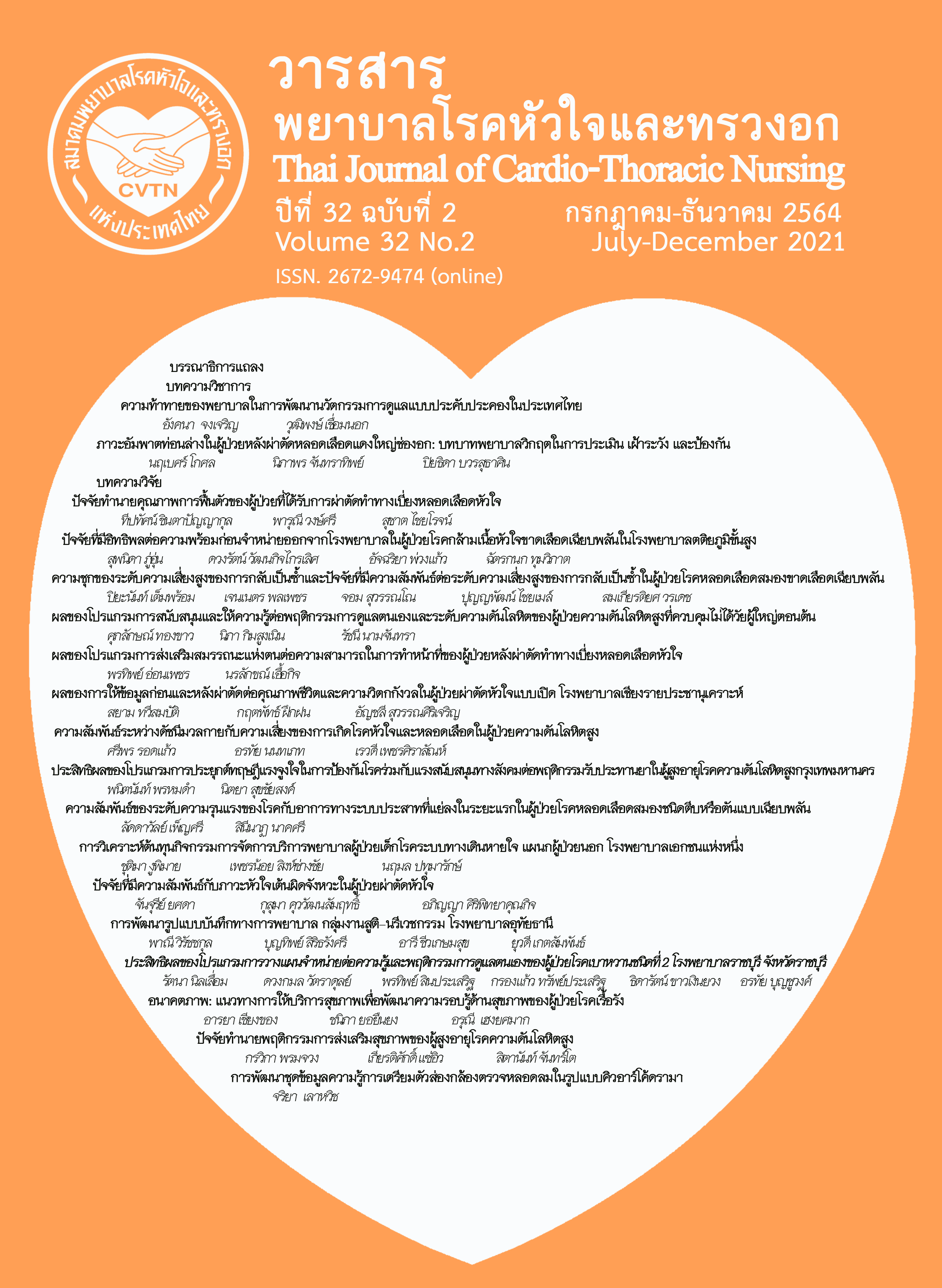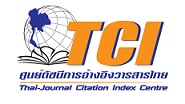Prevalence of high risk of recurrent stroke and factors associated with high risk of recurrent stroke among acute ischemic stroke patients
Keywords:
acute ischemic stroke patient, prevalence, high risk recurrent strokeAbstract
The purpose of this study aimed to investigate prevalence of high risk of recurrent stroke and factors associated with high risk of recurrent stroke among acute ischemic stroke. This study was retrospective research and analyzed the secondary data. In total, 3,135 patients with acute ischemic stroke were enrolled. Data were analyzed by using descriptive statistics and multiple logistic regression
Results revealed that sample had high risk of recurrent stroke was 38.9% (95%CI; 37.1-40.7). The female had high risk of recurrent stroke less than male 33% (AOR= 0.67, 95%CI: 0.55-0.81). The positive factors which were significantly associated with high risk of recurrent stroke was dyslipidemia (AOR= 3.14, 95%CI: 2.64-3.74), atrial fibrillation (AOR= 1.82, 95%CI: 1.21-2.72), severity of brain traumatic injury in moderate (AOR=1.48, 95%CI: 1.12-1.97) and severe level (AOR = 2.05, 95%CI:1.24-3.40), severity of stroke in moderate (AOR=1.37, 95%CI:1.13-1.65) and severe level (AOR= 1.66, 95%CI: 1.16-2.38)
This study suggests that acute ischemic stroke patients with high risk level of recurrent stroke, especially who were male and had atrial fibrillation, dyslipidemia, and moderate to severe levels of brain traumatic injury and severity of stroke. Nurses should provide special continuing care for them in order to prevent recurrent stroke.
References
Aarnio K, Haapaniemi E, Melkas S, Kaste M, Tatlisumak T, Putaala J. Long term mortality after first ever and recurrent stroke in young adults. Stroke. 2014;45:2670-6.
Lv Y, Fang X, Asmaro K, Liu H, Zhang X, Zhang H, et al. Five-year Prognosis after Mild to Moderate Ischemic Stroke by Stroke Subtype: A Multi-Clinic Registry Study. PLoS ONE. 2013;8(11):1-7.
Han DS, Pan SL, Chen SY, Lie SK, Lien IN, Wang TG. (2008). Predictors of long term survival after stroke in Taiwan. J Rehabil Med. 2008;40:844-9.
Mohan KM, Crichton SL, Grieve AP, Rudd AG, Wolfe CDA, Heuschmann PU, Kolominsky-Rabas PL, Grieve AP. Risk and cumulative risk of stroke recurrence: a systematic review and Meta-analysis. Stroke. 2011;42(5):1489-94.
Arsava EM, Kim GM, Oliveira-Filho J, Gungor L, Noh HJ, Lordelo MDJ, et al. Prediction of early recurrence after acute ischemic stroke. JAMA Neurol. 2016;73(4):396-401.
Mohan KM, Crichton SL, Grieve AP, Rudd AG, Wolfe CDA, Heuschmann PU. Frequency and predictors for the risk of stroke recurrence up to 10 years after stroke: The South London Stroke Register. J Neurol Neurosurg Psychiatry. 2009;80(9):1012-8.
Tiamkao S. Recurrent ischemic stroke in Srinagarind Hospital. North- Eastern Thai Journal of Neuroscience. 2557; 6(3):31-8.(in Thai).
Diener HC. (2005). Modified-release dipyridamole combined with aspirin for secondary stroke prevention. Aging Health. 2005; 1(1):19–26.
Weimar C, Diener CH, Alberts MJ, Steg PG, Bhatt DL, Wilson PWF, et al. The Essen Stroke Risk Score predicts recurrent cardiovascular events a validation within the reduction of atherothrombosis for continued health (REACH) Registry. Stroke. 2009; 40:350-4.
Weimar C, Beneman J, Michalski D, Muller M, Luckner K, Katsarava Z, et al. Prediction of recurrent stroke and vascular death in patients with transient ischemic attack or nondisabling stroke. Stroke. 2010; 41:487-93.
Weimar C, Siebler M, Brandt T, Romer D, Rosin L, Bramlage P, et al. Vascular risk prediction in ischemic stroke patients undergoing in-patient rehabilitation – insights from the investigation of patients with ischemic stroke in neurologic rehabilitation (INSIGHT) registry.Int J Stroke. 2011; 8(7):503-9.
Chandratheva A, Geraghty OC, Rothwell, PM. Poor performance of current prognostic scores for early risk of recurrence after minor stroke. Stroke. 2011; 42:632-7.
Meng X, Wang Y, Zhao X, Wang C, Li H, Liu L, et al. Validation of the Essen Stroke Risk Score and the stroke prognosis instrument II in Chinese patients. Stroke. 2011; 42:3619-20.
Weimar C, Beneman J, Michalski D, Muller M, Luckner K, Katsarava Z, et al. Prediction of recurrent stroke and vascular death in patients with transient ischemic attack or nondisabling Stroke. Stroke. 2010; 41:487-93.
Liu Y, Wang Y, Li WA, Yan A, Wang Y. Validation of the Essen Stroke Risk Score in different subtypes of ischemic stroke. Neurol. Res. 2017; 39(6):504-8.
Sage JI, Van U. Risk of recurrent stroke in patients with atrial fibrillation and non-valvular heart disease. Stroke. 1983;14(4):537-40.
Chen P, Liu Y, Wang Y, Wang A, Zheng H, Zhao X, et al. A validation of the Essen Stroke Risk Score in outpatients with ischemic stroke. J Stroke Cerebrovasc Dis. 2016; 25:2189–95. doi: 10.1016/j.jstrokecerebrovasdis.2016.02.001
Chandratheva A, Geraghty OC, Rothwell PM. Poor performance of current prognostic scores for early risk of recurrence after minor stroke. Stroke. 2011; 42:632-7.
Boulanger M, DPhil LL, Lyons S, Lovett NG, Kubiak MM, Silver L, et al. Essen Risk Score in prediction of myocardial infarction after transient ischemic attack or ischemic stroke without prior coronary artery disease. Stroke. 2019; 50:3393-9.
Routledge FS, Hinderliter AL, Blumenthal JA, Sherwood A. Gender difference in the endothelial function of untreated hypertension. J Clin Hypertens (Greenwich). 2012;14(4):228–35.
Jensen-Urstad K, Johansson J. Gender difference in age-related changes in vascular function. J Intern Med. 2001; 250:29-36.
Focht KL, Gogue AM, White BM, Ellis C. Gender differences in stroke recognition among stroke survivors. J Neurosci Nurs. 2014;16(1):18-22.
Forster A, Gass A, Kern R, Wolf ME, Ottomeyer C, Zohsel K, et al. Gender differences in acute ischemic stroke etiology, stroke patterns and response to thrombolysis. Stroke. 2009;40:2428-32.
Aziz S, Ghadzi SMS, Abidin NE, Tangiisuran B, Zainal H, Looi I, et al. Gender differences and risk factors of recurrent stroke in type 2 diabetic Malaysian population with history of stroke: The observation from Malaysian National Neurology Registry. J Diabetes Res. 2019:1794267.
Samai AA, Martin-Schild S. Sex differences in predictors of ischemic stroke: current perspectives. Vasc Health Risk Manag. 2015;11:427–36.
Caso V, Paciaroni M, Agnelli G, Corea F, Ageno W, Alberti A, et al. Gender difference in patients with acute ischemic stroke. Women’s Health. 2010;6(1):51–7.
Phan HT, Blizzard CL, Reeves MJ, Thrift AG, Cadilhac DA, Sturm J, et al. Sex differences in long-term quality of life among survivors after stroke in the INSTRUCT. Stroke. 2019;50:2299-306.
Tanaka A, Cui R, Kitamura A, Liu K, Imano H, Yamagishi K, et al. Heavy alcohol consumption is associated with impaired endothelial function: The circulatory risk in communities study (CIRCS). J Atheroscler Thromb. 2016;23:1047-54.
Nilanont Y, Phattharayuttawat S, Chiewit P, Chotikanuchit S, Limsriwilai J, Chalempong L, et al. Establishment of the Thai version of National Institute of Health Stroke Scale (NIHSS) and a validation study. J Med Assoc Thai. 2010;93:171-8. (in Thai).
Kamel H, Johnson DR, Hegde M, Go AS, Sidney S, Sorel M, et al. Detection of atrial fibrillation after stroke and the risk of recurrence stroke. J Stroke Cerbrovasc Dis. 2012; 21(8):726-31.
Sader MA, Celemerjer DS. Endothelial function, vascular reactivity and gender differences in the cardiovascular system. Cardiovasc Res. 2002; 53:597–604.
Hayashi T, Yamada K, Esaki T, Kuzuya M, Satake S, Ishikawa T, et al. Estrogen increases endothelial nitric oxide by a receptor mediated system. Biochem Biophys Res Commun. 1995; 214:847–55.
Xu L, Wang YR, Li PC, Feng B. Advanced glycation end product increase lipids accumulation in macrophage through upregulation of receptor of advanced glycation end product: Increase uptake, esterification and decreasing efflux of cholesterol. BioMed Central. 2016;15(161):1-13.
Curtis AB, Karki R, Hattoum A, Sharma UC. Arrhythmias in patients 80 years of age: pathophysiology, management, and outcomes. J Am Coll Cardiol. 2018;71(18):2041-57.
Downloads
Published
How to Cite
Issue
Section
License
Copyright (c) 2022 Thai Journal of Cardio-Thoracic Nursing

This work is licensed under a Creative Commons Attribution-NonCommercial-NoDerivatives 4.0 International License.
บทความนี้ยังไม่เคยตีพิมพ์หรืออยู่ในระหว่างส่งไปตีพิมพ์ในวารสารอื่น ๆ มาก่อน และกองบรรณาธิการขอสงวนสิทธิ์ในการตรวจทาน และแก้ไขต้นฉบับตามเกณฑ์ของวารสาร ในกรณีที่เรื่องของท่านได้ได้รับการตีพิมพ์ในวารสารฉบับนี้ถือว่าเป็น ลิขสิทธิ์ของวารสารพยาบาลโรคหัวใจและทรวงอก





